
Essay contest winner chronicles conflict between federal and Wyoming officials over management of gray wolf population in the state.
Marking the end of a decade-long fight between the U.S. Fish and Wildlife Service (FWS) and the state of Wyoming, the FWS in 2012 made the decision to remove Wyoming’s gray wolves from the endangered species list, eliminating federal protection for about 100 wolves.
The FWS decision put the Wyoming Game and Fish Commission in charge of managing the state’s gray wolf population, an outcome that Wyoming officials heralded as a victory for the state and for its wolves.
For over 30 years, the FWS has protected the gray wolf as an endangered species throughout the Midwest and Northwest. In 2003, the FWS gave notice of a proposed rule to delist the gray wolf from the endangered species list, in large part because of the success of the endangered species protection. The FWS approved delisting in nearby Idaho and Montana, but did not delist gray wolves in Wyoming because the FWS concluded that the state lacked the regulatory infrastructure to maintain the gray wolf population. After unsuccessfully challenging the FWS decision in court, Wyoming state officials petitioned the agency for renewed consideration in 2005. The FWS again refused to delist the wolves in Wyoming, and yet again Wyoming officials unsuccessfully challenged the agency in court.
The stream of litigation ceased momentarily when the Wyoming legislature created new laws to protect gray wolves in 2007. Yet that did not end the contentious court battles. Legal action brought by environmental groups prevented the FWS from accepting the state’s new conservation program. The FWS attempted to find a middle ground by adopting a partial delisting, but challenges from both sides barred implementation.
As legal battles raged, Wyoming leaders looked for alternative ways to persuade the FWS to remove gray wolves in the state from the endangered species list. The state legislature went back to the drawing board twice to create new regulatory schemes seeking to satisfy FWS requirements. Federal representatives weighed in as well. For example, Representative Cynthia Lummis (R-WY) succeeded in adding language to a Department of Interior appropriations bill that, if adopted, would have exempted any decision to delist the gray wolf from legal challenge.
In 2011, Wyoming’s Governor Matt Mead (R), just after replacing his Democratic predecessor who had begun the renewed effort to have Wyoming’s gray wolves delisted, portrayed wolf protections as a burden on cattle and sheep ranchers. But critics of the delisting have noted that wolves kill less than one thousandth of a percent of the cattle raised in the Northwest.
Journalists have suggested that some citizens see the wolf as a menace that should be eradicated completely or view hunting restrictions as “gun control in disguise.” Other pundits argue that anti-protection sentiment boils down to simple federalism and states’ rights principles.
Whatever the motivation, delisting clearly is not a niche issue for affected populations in the Northwest United States. Montana and Idaho have also made legislative accommodations in an effort to speed up the delisting of the gray wolf. Colorado, North Dakota, Oregon, Washington, and Utah also advocated for delisting.
This essay is the first installment in The Regulatory Review’s three-part series, Regulatory Essay Competition Winners.
Editor’s Note: As of the date of this posting, the state of Wyoming continues to be responsible for the management of the Wyoming gray wolf population. More information about the status of gray wolf populations can be found on the FWS’s website.



